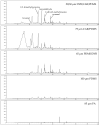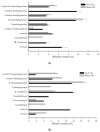Headspace Solid-Phase Microextraction Analysis of Volatile Components in Peanut Oil
- PMID: 34072807
- PMCID: PMC8197802
- DOI: 10.3390/molecules26113306
Headspace Solid-Phase Microextraction Analysis of Volatile Components in Peanut Oil
Abstract
Peanut oil is favored by consumers due to its rich nutritional value and unique flavor. This study used headspace solid-phase microextraction (HS-SPME) combined with gas chromatography (GC) and gas chromatography-mass spectrometry (GC-MS) to examine the differences in the peanut oil aroma on the basis of variety, roasting temperatures, and pressing components. The results revealed that the optimal conditions for extracting peanut oil were achieved through the use of 50/30 μm DVB/CAR/PDMS fibers at 60 °C for 50 min. The primary compounds present in peanut oil were pyrazines. When peanuts were roasted, the temperature raised from 120 °C to 140 °C and the content of aldehydes in peanut oil increased; however, the content of aldehydes in No. 9 oil at 160 °C decreased. The components of peanut shell oil varied depending on the peanut variety. The most marked difference was observed in terms of the main compound at the two roasting temperatures. This compound was a pyrazine, and the content increased with the roasting temperature in hekei oils. When the roasting temperature was lower, No. 9 oil contained more fatty acid oxidation products such as hexanal, heptanal, and nonanal. When the roasting temperature increased, No. 9 oil contained more furfural and 5-methylfurfural. Heren oil was easier to oxidize and produced nonanal that possessed a fatty aroma.
Keywords: Arachis hypogaea; GC; HS-SPME; peanut oil; pyrazines.
Conflict of interest statement
The authors declare no conflict of interest.
Figures









Similar articles
-
Characterization of Key Aroma Compounds and Main Contributing Amino Acids in Hot-Pressed Oil Prepared from Various Peanut Varieties.Molecules. 2024 Apr 24;29(9):1947. doi: 10.3390/molecules29091947. Molecules. 2024. PMID: 38731439 Free PMC article.
-
Changes in volatile compounds of peanut oil during the roasting process for production of aromatic roasted peanut oil.J Food Sci. 2011 Apr;76(3):C404-12. doi: 10.1111/j.1750-3841.2011.02073.x. Epub 2011 Mar 21. J Food Sci. 2011. PMID: 21535807
-
Application of solid phase-microextraction (SPME) and electronic nose techniques to differentiate volatiles of sesame oils prepared with diverse roasting conditions.J Food Sci. 2011 Jan-Feb;76(1):C80-8. doi: 10.1111/j.1750-3841.2010.01954.x. Epub 2011 Jan 6. J Food Sci. 2011. PMID: 21535659
-
Flavor of Peanut oil: An overview of odorants, analytical techniques, factors affecting flavor characteristics.Food Chem. 2025 Aug 15;483:144283. doi: 10.1016/j.foodchem.2025.144283. Epub 2025 Apr 9. Food Chem. 2025. PMID: 40245632 Review.
-
Effect of oilseed roasting on the quality, flavor and safety of oil: A comprehensive review.Food Res Int. 2021 Dec;150(Pt A):110791. doi: 10.1016/j.foodres.2021.110791. Epub 2021 Oct 29. Food Res Int. 2021. PMID: 34865806 Review.
Cited by
-
Effects of Different Extraction Methods on Vanilla Aroma.Molecules. 2022 Jul 19;27(14):4593. doi: 10.3390/molecules27144593. Molecules. 2022. PMID: 35889468 Free PMC article.
-
Phytochemical characterization of peanut oil and its ozonized form to explore biological activities in vitro.AMB Express. 2025 May 14;15(1):76. doi: 10.1186/s13568-025-01849-x. AMB Express. 2025. PMID: 40369380 Free PMC article.
-
Impact of Feeding Probiotics on Blood Parameters, Tail Fat Metabolites, and Volatile Flavor Components of Sunit Sheep.Foods. 2022 Aug 31;11(17):2644. doi: 10.3390/foods11172644. Foods. 2022. PMID: 36076827 Free PMC article.
-
Investigation of aroma characteristics of seven Chinese commercial sunflower seed oils using a combination of descriptive Analysis, GC-quadrupole-MS, and GC-Orbitrap-MS.Food Chem X. 2023 Apr 26;18:100690. doi: 10.1016/j.fochx.2023.100690. eCollection 2023 Jun 30. Food Chem X. 2023. PMID: 37179977 Free PMC article.
-
Study of volatile compounds in Greek pistachio (Pistacia vera L. 'Aegina' cultivar) oils using Soxhlet and ultrasound assisted extraction.Heliyon. 2023 Apr 20;9(5):e15623. doi: 10.1016/j.heliyon.2023.e15623. eCollection 2023 May. Heliyon. 2023. PMID: 37153392 Free PMC article.
References
MeSH terms
Substances
Grants and funding
LinkOut - more resources
Full Text Sources
Miscellaneous

